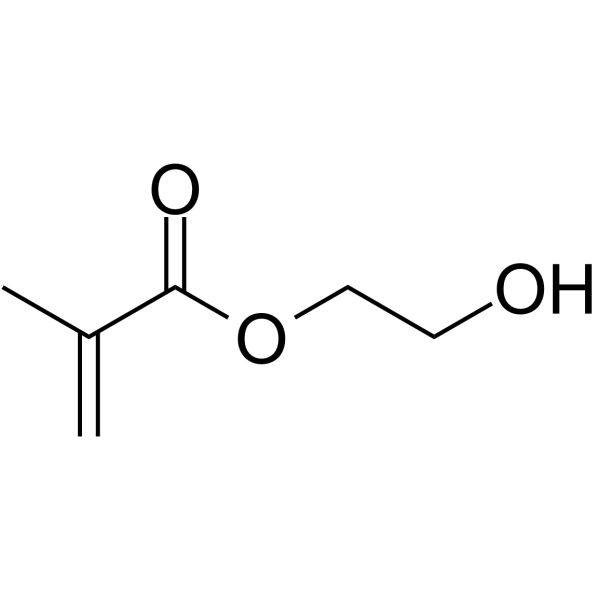2-Hydroxyethyl methacrylate

2-Hydroxyethyl methacrylate structure
|
Common Name | 2-Hydroxyethyl methacrylate | ||
|---|---|---|---|---|
| CAS Number | 868-77-9 | Molecular Weight | 130.14 | |
| Density | 1.1±0.1 g/cm3 | Boiling Point | 189.0±0.0 °C at 760 mmHg | |
| Molecular Formula | C6H10O3 | Melting Point | -12 °C | |
| MSDS | Chinese USA | Flash Point | 97.2±0.0 °C | |
| Symbol |

GHS07 |
Signal Word | Warning | |
|
Injectable Peptide Decorated Functional Nanofibrous Hollow Microspheres to Direct Stem Cell Differentiation and Tissue Regeneration.
Adv. Funct. Mater. 25(3) , 350-360, (2015) Injectable microspheres are attractive stem cell carriers for minimally invasive procedures. For tissue regeneration, the microspheres need to present the critical cues to properly direct stem cell differentiation. In natural extracellular matrix (ECM), growt... |
|
|
Polymer hydrogel functionalized with biodegradable nanoparticles as composite system for controlled drug delivery.
Nanotechnology 26(1) , 015602, (2015) The possibility to direct pharmacological treatments targeting specific cell lines using polymer nanoparticles is one of the main novelties and perspectives in nanomedicine. However, sometimes, the ability to maintain NPs localized at the site of the injectio... |
|
|
Inverse colloidal crystal membranes for hydrophobic interaction membrane chromatography.
J. Sep. Sci. 38 , 2819-25, (2015) Hydrophobic interaction membrane chromatography has gained interest due to its excellent performance in the purification of humanized monoclonal antibodies. The membrane material used in hydrophobic interaction membrane chromatography has typically been comme... |
|
|
In vitro analysis of riboflavin-modified, experimental, two-step etch-and-rinse dentin adhesive: Fourier transform infrared spectroscopy and micro-Raman studies.
Int. J. Oral Sci. 7 , 110-24, (2015) To modify two-step experimental etch-and-rinse dentin adhesive with different concentrations of riboflavin and to study its effect on the bond strength, degree of conversion, along with resin infiltration within the demineralized dentin substrate, an experime... |
|
|
Compositional design and optimization of dentin adhesive with neutralization capability.
J. Dent. 43 , 1132-9, (2015) The objective of this work was to investigate the polymerization behavior, neutralization capability, and mechanical properties of dentin adhesive formulations with the addition of the tertiary amine co-monomer, 2-N-morpholinoethyl methacrylate (MEMA).A co-mo... |
|
|
Crosstalk between VEGF and MTA1 signaling pathways contribute to aggressiveness of breast carcinoma.
Mol. Carcinog. 54(5) , 333-50, (2015) The expression of metastasis associated protein (MTA1) correlates well with tumor metastasis; however its role as a proangiogenic protein and the molecular mechanisms underlying the same are not fully understood. In this study the MTA1 protein was expressed a... |
|
|
A biodistribution study of PEGylated PCL-based nanoparticles in C57BL/6 mice bearing B16/F10 melanoma.
Nanotechnology 25(33) , 335706, (2014) One of the major drawbacks that limits the clinical application of nanoparticles is the lack of preliminary investigations related to their biocompatibility, biodegradability and biodistribution. In this work, biodegradable PEGylated polymer nanoparticles (NP... |
|
|
Magnetic high throughput screening system for the development of nano-sized molecularly imprinted polymers for controlled delivery of curcumin.
Analyst 140(9) , 3113-20, (2015) Curcumin is a versatile anti-inflammatory and anti-cancer agent known for its low bioavailability, which could be improved by developing materials capable of binding and releasing drug in a controlled fashion. The present study describes the preparation of ma... |
|
|
Restricted access molecularly imprinted polymers obtained by bovine serum albumin and/or hydrophilic monomers' external layers: a comparison related to physical and chemical properties.
Analyst 140 , 7768-75, (2015) Molecularly imprinting polymers (MIPs) can be modified with external layers in order to obtain restricted access molecularly imprinted polymers (RAMIPs) able to exclude macromolecules and retain low weight compounds. These modifications have been frequently a... |
|
|
Formation and antifouling properties of amphiphilic coatings on polypropylene fibers.
Biomacromolecules 13(11) , 3769-79, (2012) We describe the formation of amphiphilic polymeric assemblies via a three-step functionalization process applied to polypropylene (PP) nonwovens and to reference hydrophobic self-assembled n-octadecyltrichlorosilane (ODTS) monolayer surfaces. In the first ste... |